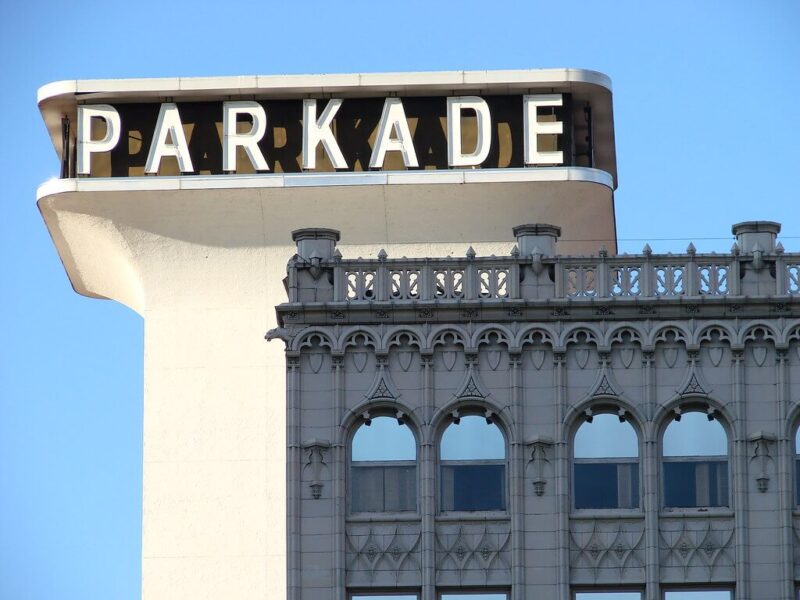While you are exploring downtown Spokane, it is hard to miss the prominent “PARKADE” sign. Towering above the surrounding buildings, it beckons travelers as much with its distinctive architecture as it does with its promise of hundreds of parking spaces.

Indeed, the Parkade Plaza (or simply, “The Parkade”) has become one of Spokane’s most iconic structures. Not only that, but it serves as a spectacular example of the meeting point between architectural design and city planning. The Parkade did not just give people a spot to park—it revitalized a languishing downtown district when Spokane needed it most.
The Growth of the Automobile Industry Posed a Paradox in Downtown Spokane
To understand the context behind the Parkade, we can turn to the Society of Architectural Historians (SAH). The society explains that the increasing production and adoption of automobiles was having a negative impact on downtown Spokane.
SAH says, “By 1965, American automobile makers were generating more than nine million cars a year, continuously offering new models. These increases gave rise to newly built highways and, in turn, accelerated the postwar flight from American downtowns to the far-flung, expanding suburbs on the edges.”
Basically, the downtown streets were clogged with automobile traffic—but at the same time, middle class residents and visitors preferred to keep to the suburbs. How could the city salvage its downtown district before it succumbed to growing blight?
The non-profit organization Spokane Unlimited Inc. proposed a solution: a $350 million parking garage. The structure would replace six buildings that would be demolished for the project, and would help solve both problems simultaneously: downtown traffic congestion and neglect. Rising 188 feet, it would offer hundreds of parking spaces when it opened in 1967.
With easier driving and parking and more direct access to local businesses, downtown Spokane soon became attractive again to the middle class.
Who Was Warren C. Heylman?
The architect hired for the Parkade project was Warren C Heylman, a prolific designer whose portfolio ultimately included over 1,000 works. The Washington Department of Archaeology and Historic Preservation writes that some of his unusual designs were the subject of “controversy,” particularly among the public. The site quotes him as explaining, “It’s not necessary for a building to look commercial to do the job … I’ve been criticized for some of the things I’ve done. Doing what you think is right is not always popular.” Thankfully, in the case of the Parkade, it was.
There is Function in Every Aspect of Heylman’s Beautiful Design

You will notice that the garage floors feature a gentle incline. This feature is more than just aesthetically pleasing. It also makes it possible to fit more parking spaces into the same footprint.

The slender columns on the Parkade draw the eye upward while simultaneously bringing a surprisingly delicate element to the otherwise imposing façade. Note the curved lip at the top of the building. It is not merely decorative. It also provides shelter from the rain, protecting the façade from Pacific Northwest weather damage.

Spokane’s skywalk system was innovative and extension when the city introduced it. Incorporating skywalks into a garage was remarkable at the time.

Even the gently arcing ramp leading up to the second floor from the street level enhances the beauty of the parking garage. The shapes of the awnings above also mirror the arch supports for the ramp below.
Visiting the Parkade Today
The Parkade remains in use today, providing easy access to locations such as Riverpark Square, Nordstrom, AMC, the Davenport Grand Hotel, the Convention Center, Spokane’s Opera House, and various shops and restaurants. You can view hours and rates or pay online at the Parkade’s official website.
Be sure to follow us on Instagram, Facebook and Pinterest. to discover more examples of MCM architecture in Washington State and beyond.












